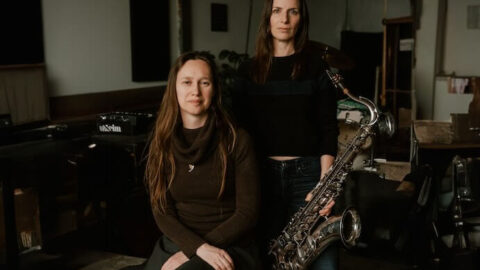In the wake of a recent solar eclipse, contemplating light, its path, and our place in it just feels right, as if to say this cosmic ritual is ever open for us to participate. We find ample space to ponder in Skylighght, in which vocalist Gelsey Bell and saxophonist Erin Rogers embrace the performer’s role as researcher by offering an archive of experimental techniques. Out May 10 on Chaikin Records, the album’s richness in concept and sound is not only a testament to their long standing collaboration, but also the instruments, bodies, communities, and environments that orbit such a relationship.
The album’s title takes inspiration from Aram Saroyan’s one-word poem lighght, a controversial entry in minimalist poetry – it sparked outrage over the National Endowment for the Arts’ funding, clocking in at $107 per letter. A poem with both an instant yet perhaps also confused reading, lighght sets up a multiplicity of ways that we can engage with this album. The track titles share the same succinct nature of the poem, zipping off the tongue and the eye. Each is an example of a natural skylight, including chasms, caves, and abysses, that call us to expand our definitions of light and sky. The reference to Saroyan’s poem anchors the project’s multidimensionality in an artistic lineage and proposition wherein a poem is an image, the work is the thing it attempts to describe.
Bell and Rogers understand that their ruminations over transference and collaborative space which buttress this album cannot involve rushing. The Skylighght project spans over five years of developing what the duo categorizes as more “experimental choreography than ‘conventional’ music composition.” A straight listen from top to bottom takes us through Bell and Rogers’ experimentation log entries in an order that works splendidly, but hopping around from piece to piece, sifting through and comparing research notes, feels equally fitting. The titles of the five tracks lend us an awareness of time bigger than the duration of an album, thus effectively priming us to look out for what seems to be unchanging yet is indeed in flux.
“Echidna Chasm” and “Antelope Canyon,” which bookend the project, share the same instructional prose score, and their presence at the beginning and end of the album gestures toward the myriad possibilities of the project’s central technique, wherein Bell sings into the bell of Rogers’ saxophone. Rogers opens with a droned B-flat, flickering and billowing in and out of upper harmonics. Singing into the bell of the instrument, Bell’s clear and steady oohs disrupt and float above the saxophone’s sustained lines to locate and push into resulting multiphonics. The pair’s experience with the technique shines through, though the score allows them to maintain a serendipitous effect; certain instances of Bell’s glissando lines rub against Rogers’ overblown textures just so, and they remain in the liminal space between notes and breaths as long as they can.
The duo continues to dance across the line between knowing intent and discovery in “Anhumas Abyss,” named for one of the deepest underground caverns in Brazil, which was accidentally discovered after a fire and can only be reached by a 236-ft rappel. Utilizing a range of extended techniques including tongue and key clicks, air notes, tea-kettle whistles, and yodel-like inflections, Bell and Rogers playfully traverse thinner textures, their delicacy and mutual inertia evoking light moving through rippling water. At the track’s climax, a swiftly moving saxophone line and Bell’s long oohs give way to full throated belts against Rogers’ multiphonics.

“Nereo Cave” finds us still in the dark with a thin stream of air that blossoms into pronounced clicks, two- and three-note patterns, and a variety of vocal timbres and mouth shapes, not unlike the structure and explorations of “Anhumas Abyss.” Bell and Rogers’ contributions here invigorate the lineage of American experimentalism – the references to underground bodies of water recall Pauline Oliveros’ improvised recording sessions in the Dan Harpole cistern. Bell allows ample space for her vocal interjections to be acted upon by the sound of Rogers’ tapping and playing. The duo retreats from the groove in the loudest moment of the track with animal-like whoops and cries, clicks, and breathy inflections, which give an almost casual air, as if to remind us that research is practice, and practice is fun.
On most of the album’s tracks, Bell and Rogers play into dark waters and deep rifts in the earth, but on “Twin Pollux,” they play into the stars. The central track of the album opens with ambient sounds of chirping summer insects before the duo gently enters the foray with unison long tones, mirroring each other’s sound and petering out organically. In mythology, Pollux elects to share his immortality with his twin brother Castor so that they can alternate between the realms of Olympus and Hades. In the same way, Bell and Rogers suggest a shared role – who cues their unison entrances, who imitates the other. The decision to include the specific ambience of a summer evening, where one can step outside and observe the twin constellation, brings the duo’s awareness of physical environment and timeless relationship dynamics into full focus and makes the track’s title feel utterly justified and earned. If a constellation is a skylight, what is on the other side?
I CARE IF YOU LISTEN is an editorially-independent program of the American Composers Forum, and is made possible thanks to generous donor and institutional support. Opinions expressed are solely those of the author and may not represent the views of ICIYL or ACF.
You can support the work of ICIYL with a tax-deductible gift to ACF. For more on ACF, visit the “At ACF” section or composersforum.org.
























